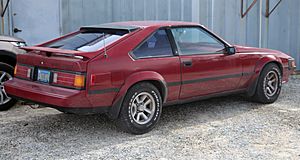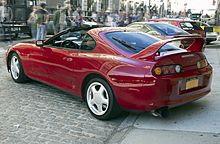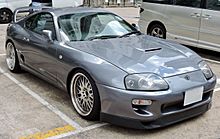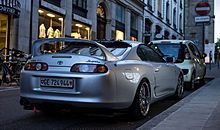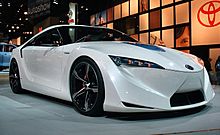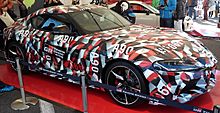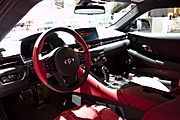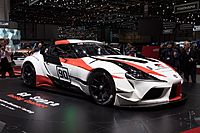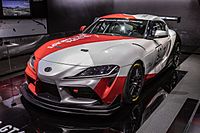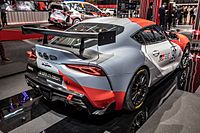Toyota Supra facts for kids
Quick facts for kids Toyota Supra |
|
|---|---|

The 2020 Toyota GR Supra (J29/DB)
|
|
| Overview | |
| Manufacturer | Toyota |
| Also called |
|
| Production |
|
| Body and chassis | |
| Class | Sports car/grand tourer |
| Body style | 3-door liftback coupé |
| Layout | Front-engine, rear-wheel-drive |
| Chronology | |
| Predecessor | Toyota Celica (A20/A30) |
The Toyota Supra is a cool sports car and grand tourer made by Toyota Motor Corporation. It first came out in 1978. The name "supra" comes from a Latin word that means "above" or "to go beyond."
Toyota made the first four versions of the Supra from 1978 to 2002. The newest version started being made in March 2019. The first Supra looked a lot like the Toyota Celica, but it was longer and wider. In 1986, the Supra became its own separate car, and Toyota stopped calling it the "Celica Supra."
The Supra also has roots from the Toyota 2000GT, another famous sports car, because they both used a special type of engine called an inline-6. The first three generations of the Supra used engines that came from the Toyota Crown and 2000GT.
Toyota even had a special logo for the Supra. It was like the Celica logo but blue. This logo was used until 1986. Then, a new orange and red logo appeared, but it didn't have the dragon design. Toyota used this logo until 1991, when they switched to their current oval company logo.
Toyota stopped selling the fourth-generation Supra in the United States in 1998. Production of that version ended in 2002. In January 2019, the fifth generation of the Supra was shown to the world. It was made together with the BMW Z4.
First Generation (1978-1981)
| First generation (A40/A50) | |
|---|---|

Toyota Celica Supra (MA47)
|
|
| Overview | |
| Also called |
|
| Production | April 1978 – June 1981 |
| Assembly | Japan: Tahara, Aichi (Tahara plant) |
| Body and chassis | |
| Related |
|
| Powertrain | |
| Engine |
|
| Transmission | |
| Dimensions | |
| Wheelbase | 2,630 mm (103.5 in) |
| Length | 4,600–4,615 mm (181.1–181.7 in) |
| Width | 1,650 mm (65.0 in) |
| Height | 1,290–1,310 mm (50.8–51.6 in) |
| Weight | 1,150–1,270 kg (2,535–2,800 lb) |
The first Toyota Supra was mostly based on the Toyota Celica liftback. It was about 130 mm (5.1 in) longer than the Celica. The doors and back part were the same as the Celica. But the front part was made longer to fit a bigger Inline-6 engine instead of the Celica's 4-cylinder engine. Toyota wanted the Supra to compete with the popular Datsun Z-car.
1978 Supra Features
Toyota started making the Supra in Japan in April 1978. It was called the Celica XX there. It was sold alongside the Celica at special Toyota stores.
The Supra came with two engine choices. A smaller 2.0-liter engine was available in Japan. This was so buyers wouldn't have to pay extra taxes for a larger car. Both engines used electronic fuel injection.
The Supra was first sold outside Japan in January 1979. These models had a 2.6-liter engine with 110 hp (82 kW; 112 PS).
You could choose between a 5-speed manual or a 4-speed automatic transmission. Both had an overdrive gear to save fuel at high speeds. The car also had disc brakes on all four wheels. It had a special suspension system to make the ride smooth and stable.
Inside, the Supra had cool features. You could get optional power windows and power locks. It also had cruise control and a special map light. Other standard features included a tilt steering wheel and storage areas. The dashboard had a radio, a clock, and a tachometer to show engine speed.
Updates in 1979 and 1980
In mid-1979, the US model got some small changes. The inside had a new center console and a digital clock. Outside, the side mirrors were redesigned. Aluminum wheels became standard. Mudflaps were also added, often painted to match the car's color.
For the 1981 model year, the Supra got a bigger 2.8-liter engine. This engine had 116 hp (87 kW; 118 PS). The automatic transmission was also updated. This new model was called the MA47. It could go from 0 to 60 mph (97 km/h) in about 10.24 seconds.
A new Sports Performance Package was offered in 1980. It included a sportier suspension and spoilers. This was also the last year you could get an 8-track tape player in a Supra!
Celica XX in Japan
The Celica XX was the name for the first-generation Celica Supra in Japan. It was sold from 1978 to 1981. Toyota even worked with Lotus Cars on some parts for this car. In 1981, the Celica XX was the first car in the world to have a navigation computer!
Second Generation (1981-1985)
| Second generation (A60) | |
|---|---|

Toyota Celica Supra (A60)
|
|
| Overview | |
| Also called |
|
| Production | July 1981 – December 1985 |
| Assembly | Japan: Tahara, Aichi (Tahara plant) |
| Body and chassis | |
| Related |
|
| Powertrain | |
| Engine |
|
| Transmission |
|
| Dimensions | |
| Wheelbase | 2,614 mm (102.9 in) |
| Length | 4,661 mm (183.5 in) |
| Width |
|
| Height | 1,321 mm (52.0 in) |
| Weight | 1,361 kg (3,000 lb) |
In 1981, Toyota completely redesigned the Celica Supra for the 1982 model year. In Japan, it was still called the Celica XX. But for the rest of the world, it was the Celica Supra. It was still based on the Celica, but it had some big differences. The most noticeable changes were the front design and the cool pop-up headlights that could hide away.
This generation also had an inline-six engine, which was bigger than the Celica's four-cylinder engine. The car was made longer to fit this larger engine.
P-type and L-type Models
In North America, the Celica Supra came in two main types: the "Performance Type" (P-type) and the "Luxury Type" (L-type). They were the same mechanically, but they looked a bit different and had different options.
The P-type had cool fiberglass flares over the wheel wells, which made it look sportier. It also came with special eight-way adjustable seats. The L-type didn't have the flares and focused more on comfort. All P-types had 14x7-inch aluminum wheels, while L-types had smaller wheels until 1985.
Some L-type models had a digital dashboard with a trip computer. This computer could show things like how much fuel you were using and how far you could go. All P-types came with a limited slip differential, which helps the car handle better.
1982 Supra Details
For 1982, the Celica Supra in North America had a 2.8-liter engine with 145 hp (108 kW; 147 PS). This engine helped the car go from 0 to 60 mph (97 km/h) in 9.8 seconds.
The car had a 5-speed manual transmission as standard. A 4-speed automatic transmission was an option for the L-type. Both transmissions had an overdrive gear. The Supra's suspension was specially tuned by Lotus, a famous sports car company. It had power steering and disc brakes on all four wheels.
Inside, the car had standard power windows, power door locks, and power mirrors. It also had a tilt steering wheel. The automatic climate control system was also standard. You could get a sunroof, two-tone paint, and a fancy stereo system with a cassette player.
Changes in 1983 and 1984
In 1983, the engine power increased slightly to 150 hp (112 kW; 152 PS). The automatic transmission was updated to a new electronic one. This allowed the driver to choose between "power" or "normal" driving modes.
Outside, all models got mudflaps. P-type models could also have headlight washers. In 1984, the power for 5-speed models went up to 160 hp (119 kW; 162 PS). This was thanks to a redesigned engine part.
The outside look changed quite a bit in 1984. The front turn signals wrapped around the side. You could get a rear wing spoiler or window louvers. The tail lights were redesigned, and the "Supra" sticker on the back was bigger. The car's rear bumper was now the same color as the rest of the car.
Inside, the steering wheel and other controls were updated. North American models got a speedometer that went up to 130 mph (209 km/h).
1985-1986 Models
The Supra was redesigned again in 1985. Power increased a little to 161 hp (120 kW; 163 PS). This helped the Supra go from 0 to 60 mph (97 km/h) in 8.4 seconds.
Other changes included a new sunshade and a two-piece spoiler on the back. A factory theft system was added. All Supras got automatic-off lights.
Even though 1985 was supposed to be the last year for this generation, some 1985 P-type models were sold in the first half of 1986. They had small changes, like a required third brake light on the back. These were called 1986 models. Production of the A60 Supra ended in December 1985.
Third Generation (1986-1993)
| Third generation (A70) | |
|---|---|
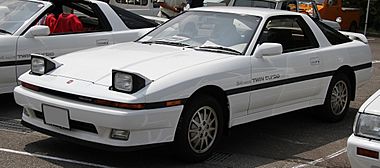
1986 Toyota Supra 2.0GT Twin Turbo (GA70)
|
|
| Overview | |
| Production | February 1986 – May 1993 |
| Assembly | Japan: Tahara, Aichi (Tahara plant; February 1986 – December 1992) |
| Body and chassis | |
| Related | Toyota Soarer (Z20) |
| Powertrain | |
| Engine |
|
| Transmission |
|
| Dimensions | |
| Wheelbase | 2,596 mm (102.2 in) |
| Length | 4,620 mm (181.9 in) |
| Width |
|
| Height |
|
| Weight |
|
In February 1986, the Celica and Supra became completely separate cars. The Celica changed to front-wheel drive, but the Supra kept its rear-wheel-drive setup. This new Supra was meant to show off Toyota's latest technology.
The A70 Supra got a more powerful 3.0-liter inline-six engine with 149 kW (200 hp; 203 PS). A turbocharged version was added in 1987. The Supra was now mechanically similar to the Toyota Soarer.
The new engine in the A70 Supra, called the Toyota 7M-GE, was one of Toyota's best. Both versions of the engine had 4 valves per cylinder. The turbocharged 7M-GTE engine was Toyota's first engine in the US without a distributor. It had 172 kW (231 hp; 234 PS). The naturally aspirated (non-turbo) engine had 149 kW (200 hp; 203 PS). By 1989, the turbo model's power increased to 173 kW (232 hp; 235 PS).
The non-turbo model came with a 5-speed manual transmission. The turbocharged models had a stronger 5-speed manual. Both could also have an optional 4-speed automatic transmission.
The third-generation Supra had lots of new technology. In 1986, you could get a 3-channel ABS (which helps prevent skidding). It also had TEMS, an electronic suspension system that let the driver choose how firm the ride was. All models had a double wishbone suspension system. You could also get a targa top (a removable roof panel) or a power sliding sunroof.
Key Updates Over the Years
- 1986.5: The third-generation Supra was launched as its own model, separate from the Celica. It had a 3.0-liter engine.
- 1987: The A70 Supra Turbo was introduced. Its turbocharged engine had 172 kW (231 hp; 234 PS). The Turbo model also had an engine oil cooler and a rear spoiler. An optional 4-channel ABS system was available.
- 1988: Small changes were made, like the shape of the spoiler brake light. The seat pattern was updated. Japanese buyers had many different versions to choose from.
- 1989: The turbo model's power increased slightly. The body molding was changed to prevent rust. A "white package" was introduced with white body parts and wheels. All models got rear 3-point seat belts. New tail lights, bumpers, and side mirrors were added. Turbo models got a three-piece spoiler with an LED brake light.
- 1990: Changes included a redesigned steering wheel with the cruise control moved. An airbag was added, and the dashboard was updated.
- 1991: The wheel design changed to 5-spoke wheels. The "Supra" emblem on the front was replaced with the oval Toyota symbol. New interior colors were introduced. Front speakers were made larger. Toyota also started offering a factory spoiler-style panel sunroof.
- 1992: Leather interiors got black seats. Non-turbo models no longer had the targa top option. A new optional subwoofer was available.
Special Japanese Models
Japanese models of the Supra had different codes: JZA70 and GA70. The JZA70 had a 2.5-liter twin-turbocharged 1JZ-GTE engine with 206 kW (276 hp; 280 PS). The GA70 had a 2.0-liter twin-turbocharged 1G-GTE engine or a non-turbo 1G-GEU engine.
A special version of the JZA70 was the 2.5 Twin Turbo R model (JZA70-R). It was lighter and faster. It had special parts like lighter sway bars, a bigger intercooler, and Recaro seats. It also came in a unique Jade Mica Green color.
The Turbo-A was a special model made for racing. Only 500 of these were built in 1988. It had a larger turbocharger and a bigger throttle body. It also had a unique "Turbo A duct" on the front to help cool the intercooler. All Turbo-A cars were black and had a special "3.0GT Turbo A" badge. They were powered by a 204 kW (274 hp; 277 PS) engine.
Fourth Generation (1993-2002)
| Fourth generation (A80) | |
|---|---|
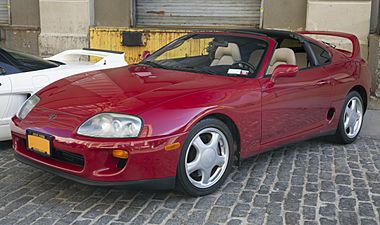
Pre-facelift Toyota Supra A80
|
|
| Overview | |
| Production | April 1993 – August 2002 |
| Assembly |
|
| Designer | Isao Tsuzuki (1990) |
| Body and chassis | |
| Related |
|
| Powertrain | |
| Engine |
|
| Transmission |
|
| Dimensions | |
| Wheelbase | 2,550 mm (100.4 in) |
| Length | 4,515–4,520 mm (177.8–178.0 in) |
| Width | 1,810 mm (71.3 in) |
| Height | 1,275 mm (50.2 in) |
| Weight |
|
The design for the fourth-generation Supra started in 1989. The final design was approved in 1990. Production began in April 1993. This new Supra also shared parts with the fancy Z30 Soarer (known as the Lexus SC in the U.S.). Even though they looked similar, the new Supra was much shorter than its luxury cousin.
Toyota really focused on making this Supra a high-performance car. It came with two new engines. A non-turbo Toyota 2JZ-GE engine had 164 kW (220 hp; 223 PS). A powerful twin turbocharged Toyota 2JZ-GTE engine had 206 kW (276 hp; 280 PS) in Japan. For other countries, Toyota made the turbo engine even stronger, with 239 kW (321 hp; 325 PS).
The turbocharged Supra could go from 0 to 97 km/h (60 mph) in as little as 4.6 seconds! It had a top speed of 160 mph (257 km/h). In Japan, cars were limited to 180 km/h (112 mph). In other countries, they were limited to 250 km/h (155 mph).
The twin turbochargers worked in a special "sequential" way. This meant one turbo would kick in first to reduce lag, giving you power right away. Then the second turbo would join in for even more power at higher speeds. This made the car feel very responsive.
The turbo models got a new six-speed manual gearbox. The non-turbo models had a five-speed manual. Both could also have a four-speed automatic transmission. All cars had five-spoke aluminum wheels. The turbo models had bigger 17-inch wheels to fit larger brakes.
Toyota worked hard to make this new Supra lighter. They used aluminum for the hood, roof, and other parts. They even used hollow carpet fibers! Despite having more features like airbags and bigger brakes, the car was at least 91 kg (200 lb) lighter than the previous model.
In 1994, Toyota Racing Development (TRD) showed off a special race car replica called the TRD3000GT. It had a wider body kit for better aerodynamics. Only 35 of these were ever made.
For the 1996 model year in the US, the turbo model was only available with an automatic transmission. The targa roof became standard on all turbo models. In 1997, the manual transmission returned for the turbo model. The car also got redesigned tail lights, headlights, and front parts. All 1997 models were called "Limited Edition 15th Anniversary."
The A80 Supra was great for racing. It also had an amazing braking system. It could stop from 113 km/h (70 mph) in just 149 ft (45 m). This was the best braking performance of any production car tested by Car and Driver magazine in 1997!
By the late 1990s, sales of sports cars were slowing down. Also, the Japanese currency became stronger, making the Supra more expensive outside Japan. The Supra was no longer sold in Canada after 1996 and in the US after 1998. Production continued in Japan until August 2002, when it stopped due to new emission rules.
Fifth Generation (2019-Present)
| Fifth generation (J29/DB) | |
|---|---|
 |
|
| Overview | |
| Also called | Toyota GR Supra |
| Production | March 2019 – present |
| Assembly | Austria: Graz, Styria (Magna Steyr) |
| Designer |
|
| Body and chassis | |
| Platform | BMW Cluster Architecture (CLAR) |
| Related | BMW Z4 (G29) |
| Powertrain | |
| Engine | |
| Power output |
|
| Transmission | 8-speed ZF 8HP automatic |
| Dimensions | |
| Wheelbase | 2,470 mm (97.2 in) |
| Length | 4,380 mm (172.4 in) |
| Width | 1,865 mm (73.4 in) |
| Height | 1,290–1,295 mm (50.8–51.0 in) |
| Weight | 1,410–1,520 kg (3,109–3,351 lb) |
How the New Supra Was Developed
People thought a new Supra might be based on the FT-HS concept car shown in 2007. Toyota said they weren't rushing to make a new Supra. They wanted to see how well their GT86/FR-S sports car sold first.
In 2010, Toyota applied to trademark the Supra name again. In 2012, the chief engineer of the Toyota 86 said that Toyota's president asked him to make a new Supra as soon as possible.
In 2014, Toyota showed off a new concept car called the FT-1. It was a front-engine, rear-wheel-drive car that took inspiration from past Toyota sports cars like the 2000GT and previous Supras. Toyota didn't say if it would be the new Supra, but they did renew the Supra trademark.
In 2016, it was reported that the new Supra would come out in 2018. It was confirmed that it would have a turbocharged inline-6 engine, likely from BMW. The new Supra is built in Austria alongside the BMW Z4.
On July 5, 2018, Toyota Gazoo Racing announced that the Supra would race in the 2019 NASCAR Xfinity Series. A camouflaged version of the new Supra was shown at the Goodwood Festival of Speed on July 12, 2018.
Launching the New Supra
The fifth generation of the Supra was officially shown at the January 2019 North American Auto Show. This car was made in a partnership between Toyota and BMW.
The very first production model was sold at an auction for $2.1 million! All that money went to charity. This special car had a matte grey outside, a red inside, and red mirrors. It also had a signature from Toyota CEO Akio Toyoda on the dashboard.
The Supra went on sale in Japan in May 2019. It started selling in the United States in July 2019 and in Australia in September 2019.
Engine and Performance
The new Supra has two engine choices from BMW: a turbocharged 2.0-liter inline-four or a turbocharged 3.0-liter inline-six engine. The 2.0-liter engine has between 145–190 kW (194–255 hp; 197–258 PS). The 3.0-liter engine has between 250–285 kW (335–382 hp; 340–387 PS). All power goes to the rear wheels through an 8-speed automatic transmission. There is no manual transmission option right now.
The 2.0-liter model can go from 0 to 97 km/h (60 mph) in 5.2 to 6.5 seconds. The 3.0-liter model is much faster, reaching 0 to 97 km/h (60 mph) in 3.9–4.1 seconds. This is even quicker than the previous generation's turbo Supra! The top speed is electronically limited to 249 km/h (155 mph).
The Supra also has a good-sized trunk, about 290 liters, which is practical because it's a liftback.
This Supra is also the first non-BMW car to be built on the BMW CLAR platform.
Models and Features
In Japan, the Supra comes in three versions: SZ, SZ-R, and RZ.
- The SZ has the 145 kW (194 hp; 197 PS) 2.0-liter engine, 17-inch wheels, and basic interior features.
- The SZ-R has the 190 kW (255 hp; 258 PS) 2.0-liter engine, 18-inch wheels, power seats, and a better sound system.
- The RZ has the 3.0-liter engine and 19-inch wheels. It has similar interior features to the SZ-R, but with different leather options.
All versions have a "Sport" mode and a special Toyota Supra Connect system. They also come with the Toyota Supra Safety suite, which includes features like automatic emergency braking and lane departure alert to help keep you safe.
In the United States, the GR Supra is offered in 3.0 and 3.0 Premium versions.
- The 3.0 has a 6.5-inch touchscreen and Alcantara seats.
- The 3.0 Premium has a larger 8.8-inch touchscreen, navigation, a 12-speaker JBL sound system, and heated leather seats.
The first 1,500 cars sold were special Launch Edition models. These were based on the 3.0 Premium and came in unique colors with special red interiors. They also had a replica of Akio Toyoda's signature on the dashboard.
For the 2021 model year, the 3.0-liter engine got even more powerful, with 285 kW (382 hp). A new 2.0 model was also launched in the US. The suspension was improved, and a larger infotainment screen became standard on all models.
Racing Concepts
GR Supra Racing Concept
The GR Supra Racing Concept is a special race car design. It was first shown at the 2018 Geneva Motor Show. It has a lowered suspension, racing wheels, special brakes, and a full roll cage for safety. Many parts, like the hood and spoiler, are made of lightweight carbon fiber.
GR Supra GT4
The GR Supra GT4 Concept is another race car designed for the European GT4 racing series. It was shown in 2019. It's lighter, has upgraded brakes and suspension, and a big rear wing. Toyota later released a production model of the GT4 race car with a 320 kW (429 hp; 435 PS) engine. It has a 7-speed automatic transmission and a special exhaust system. Inside, it has a racing seat and a carbon fiber dashboard.
Supra in Motorsport
The Toyota Supra has been used in many types of car races, like Group A races around the world and JGTC races in Japan.
Awards for the Supra
- The A60 (second generation) Supra won "Import Car of the Year" from Motor Trend magazine. It was also on Car and Driver magazine's "Ten Best list" in 1983 and 1984.
- In 1994, the A80 (fourth generation) Supra won "Design & Engineering awards" from Popular Mechanics.
Supra Timeline
- 1979: The first Celica Supra (A40) was introduced with a 2.6-liter engine.
- 1981: The A40 engine size increased to 2.8 liters.
- 1982: The A60 Celica Supra was launched with a 2.8-liter DOHC engine.
- 1986-1986.5: The A70 Supra became its own car, separate from the Celica, with a 3.0-liter DOHC engine.
- 1987: A turbocharged option became available for the 3.0-liter engine, making 172 kW (231 hp; 234 PS).
- 1989: The A70 model was redesigned, and the turbo engine's power increased to 173 kW (232 hp; 235 PS).
- 1993: The A80 Supra was introduced with new 3.0-liter turbo (2JZ-GTE) or non-turbo (2JZ-GE) DOHC engines.
- 1996: In the US, the turbo model was only available with an automatic transmission. The targa roof became standard on all turbo models.
- 1997: Manual transmission returned for turbo models. The car got new tail lights and headlights. All 1997 models were called "15th Anniversary" models.
- 1998: Small updates to the interior. Non-turbo models got VVT-i, which increased power. Turbo models were stopped in some US states.
- 1999: Supra exports to the US ended. Production continued in Japan.
- 2002: Production of the A80 Supra ended in Japan.
- 2019: The fifth generation Supra was shown at the January 2019 North American International Auto Show.
Supra in Pop Culture
The Supra has been in many popular video games like Initial D Arcade Stage, Gran Turismo, Forza Motorsport, and Need for Speed. It's also famous from The Fast and the Furious film series movies.
People sometimes use "Mark" names like "Mark I" or "Mark II" for the Supra generations, but Toyota doesn't officially use these names. Toyota uses chassis codes like A40, A60, A70, A80, and J29/DB to refer to the different generations.
Sales Numbers
| Model | Year | North America (estimated) |
UK |
|---|---|---|---|
| A40/A50
Mk I |
1979 | 26,207 | 0 |
| 1980 | 21,542 | 0 | |
| 1981 | 16,146 | 0 | |
| Total | 63,895 | 0 | |
| A60
Mk II |
1982 | 34,048 | 293 |
| 1983 | 26,972 | 1,012 | |
| 1984 | 29,871 | 1,385 | |
| 1985 | 23,568 | 1,442 | |
| Total | 114,459 | 4,132 | |
| A70
Mk III |
1986 | 33,283 | 1,294 |
| 1987 | 29,907 | 1,809 | |
| 1988 | 19,596 | 2,056 | |
| 1989 | 14,544 | 2,993 | |
| 1990 | 6,419 | 2,285 | |
| 1991 | 3,623 | 711 | |
| 1992 | 1,193 | 403 | |
| Total | 108,565 | 11,551 | |
| A80
Mk IV |
1993 | 2,901 | 192 |
| 1994 | 3,405 | 212 | |
| 1995 | 2,266 | 150 | |
| 1996 | 852 | 69 | |
| 1997 | 1,379 | 0 | |
| 1998 | 1,232 | 0 | |
| 1999 | 24 | 0 | |
| Total | 12,059 | 623 | |
| J29/DB
Mk V |
2019 | 2,884 | 190 |
See also
 In Spanish: Toyota Supra para niños
In Spanish: Toyota Supra para niños





